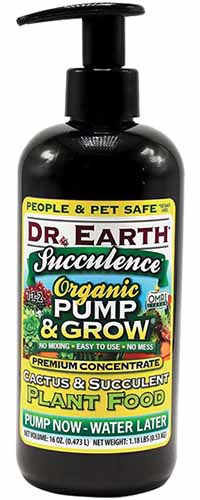How to Grow and Care for String of Pearls
Senecio rowleyanus
The string of pearls plant, Senecio rowleyanus, is a funky succulent vine with rounded leaves that look like strands of pearls or peas. Formerly classified as Curio rowleyanus, it is also commonly called string of beads.
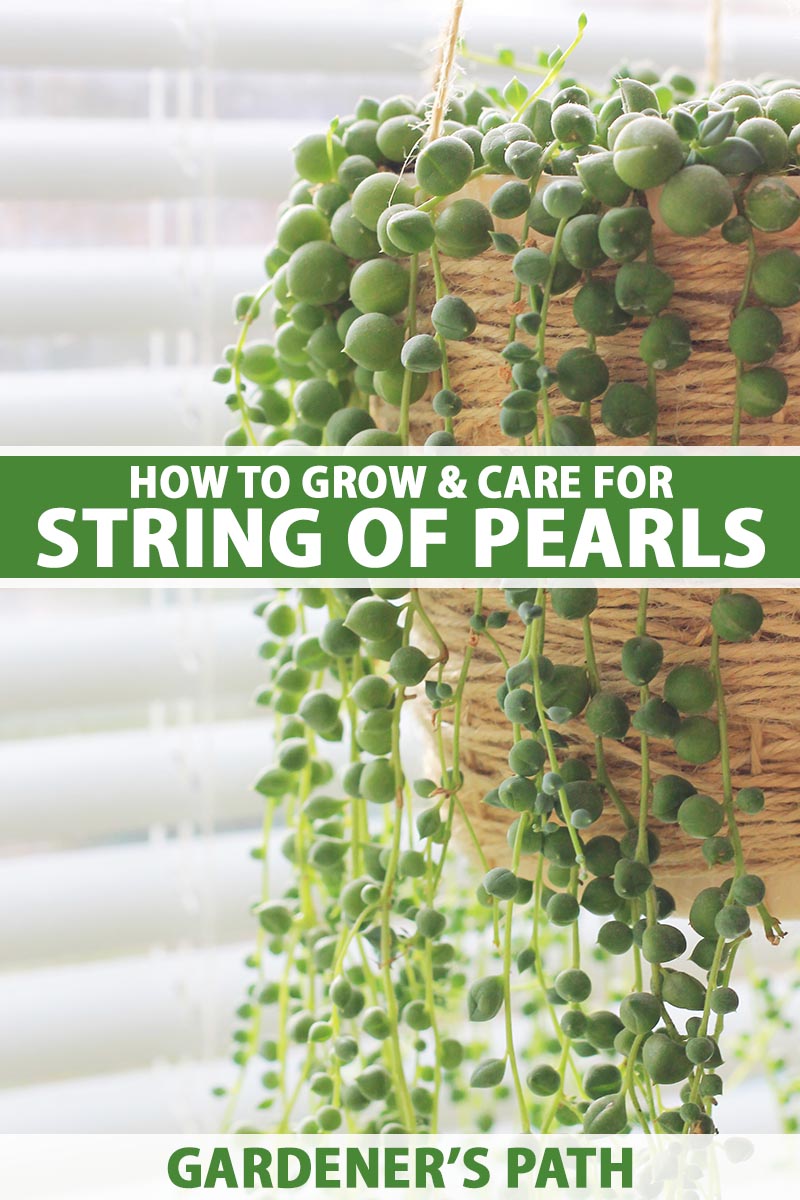
We link to vendors to help you find relevant products. If you buy from one of our links, we may earn a commission.
Native to South Africa, it’s suited to outdoor cultivation in USDA Hardiness Zones 9 to 12 and grows as a houseplant in all regions.
And as with many ornamental species, it’s toxic to people and pets, so don’t eat it and wear gloves to protect sensitive skin from contact dermatitis.
If you are as intrigued by S. rowleyanus as I am, read on for all you need to know to grow it indoors.
Here’s what we’ll cover:
What You’ll Learn
Let’s start with a little background.
What Is String of Pearls?
German botanist Herman Jacobsen identified S. rowleyanus in 1968, naming it for famed British plant hunter, botanist, collection curator, and writer Gordon Douglas Rowley.
Without their efforts, string of pearls might not be available to home gardeners worldwide today.
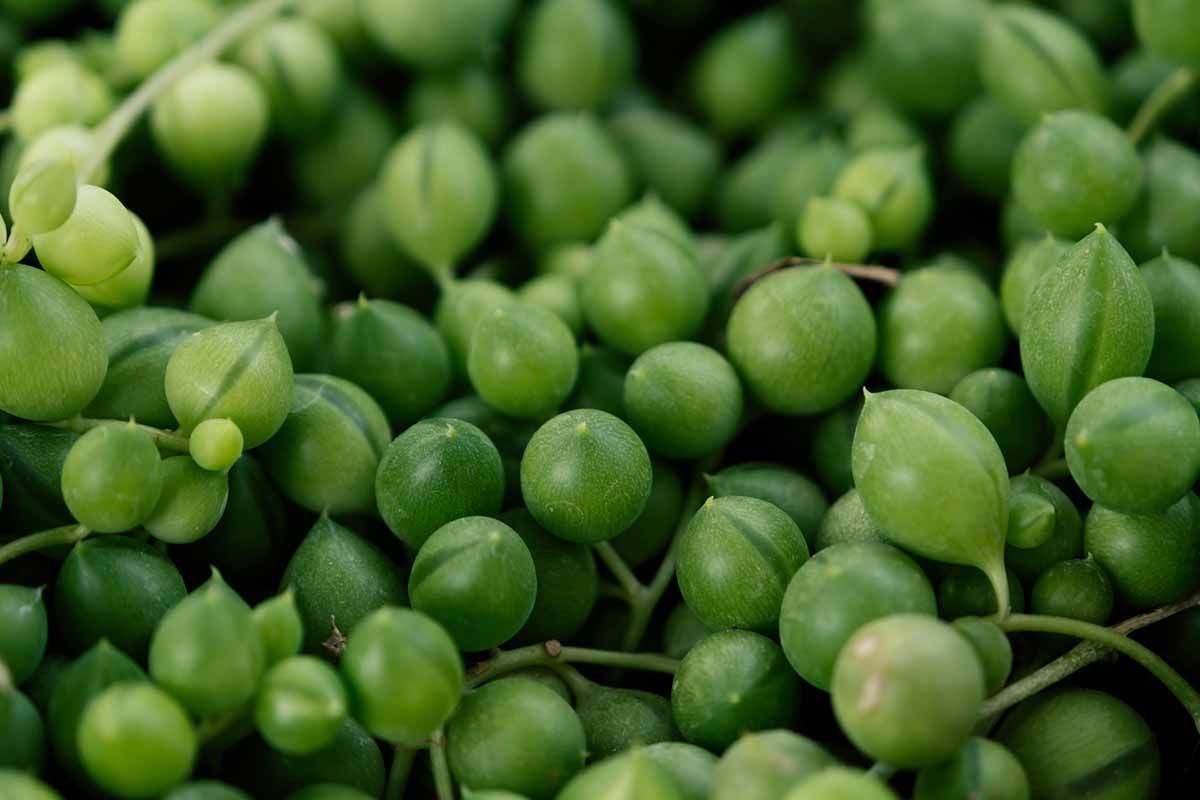
The pearl-like leaves of our subject species are plump water storage vessels. Unlike some succulents, the stems are not engorged with moisture but are slender and somewhat fragile.
Each leaf has a noticeable dark green line that looks like a slit. This is a fenestration or epidermal window equipped to receive optimal sunlight for photosynthesis.
S. rowleyanus copes with its arid environment by creeping horizontally, pushing roots into the soil, and forming a thick green ground cover. As it grows, it seeks shelter from the scalding sun and is often found in rock crevices and beneath trees.
Indoors, plants thrive in bright indirect sunlight. They are eye-catching in hanging containers that showcase their trailing vines.
Mature dimensions average one to two feet long and wide. However, three-foot lengths are possible under optimal conditions.
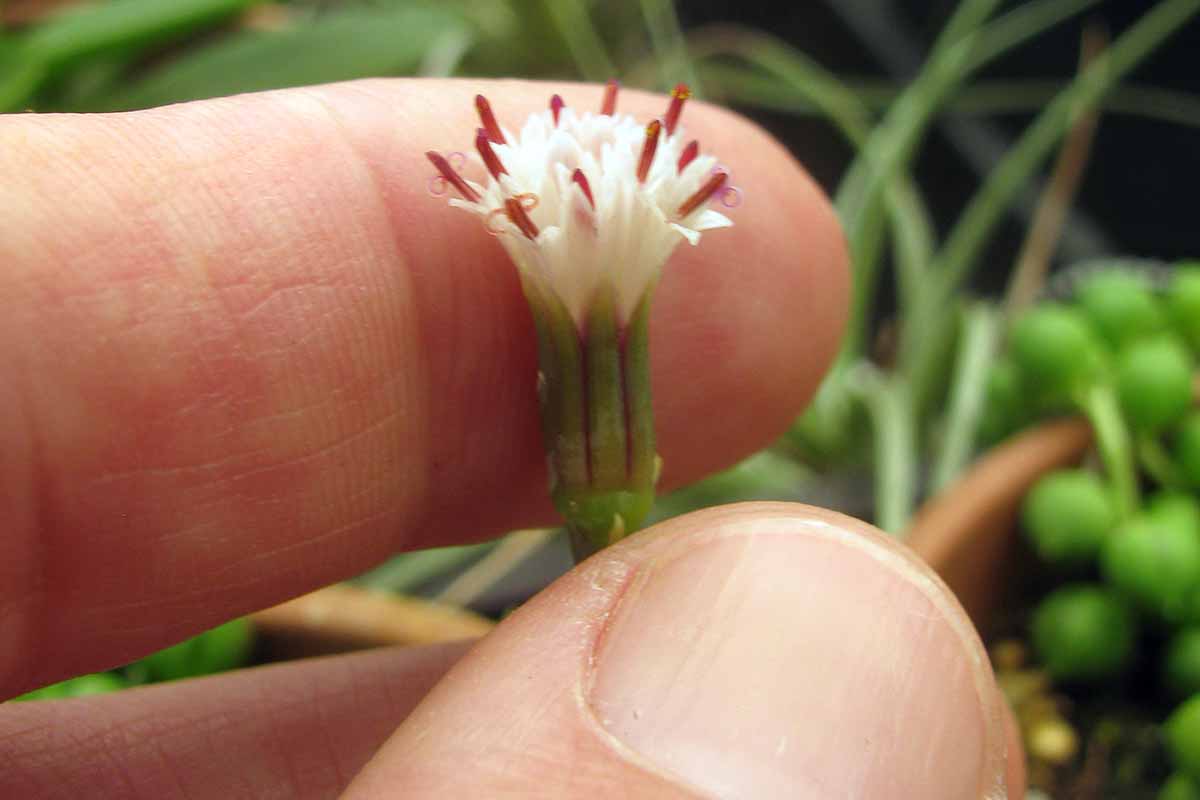
Small white blossoms with a cinnamon-like fragrance may bloom in the summertime, although this is more likely with outdoor flora.
When the flowers set seed, each has a fluffy “pappus,” like an aster or dandelion, that nature’s breezes would readily disperse in outdoor settings. Houseplant flowers are generally unpollinated and the seeds are unlikely to germinate.
Does string of pearls sound like a worthy contender for a new or existing succulent collection? Read on for guidance on propagating a plant of your own.
Propagation
There are several ways to start a plant.
Seeds are not readily available, as it’s much easier and faster to propagate succulents by taking leaf or stem cuttings and rooting them.
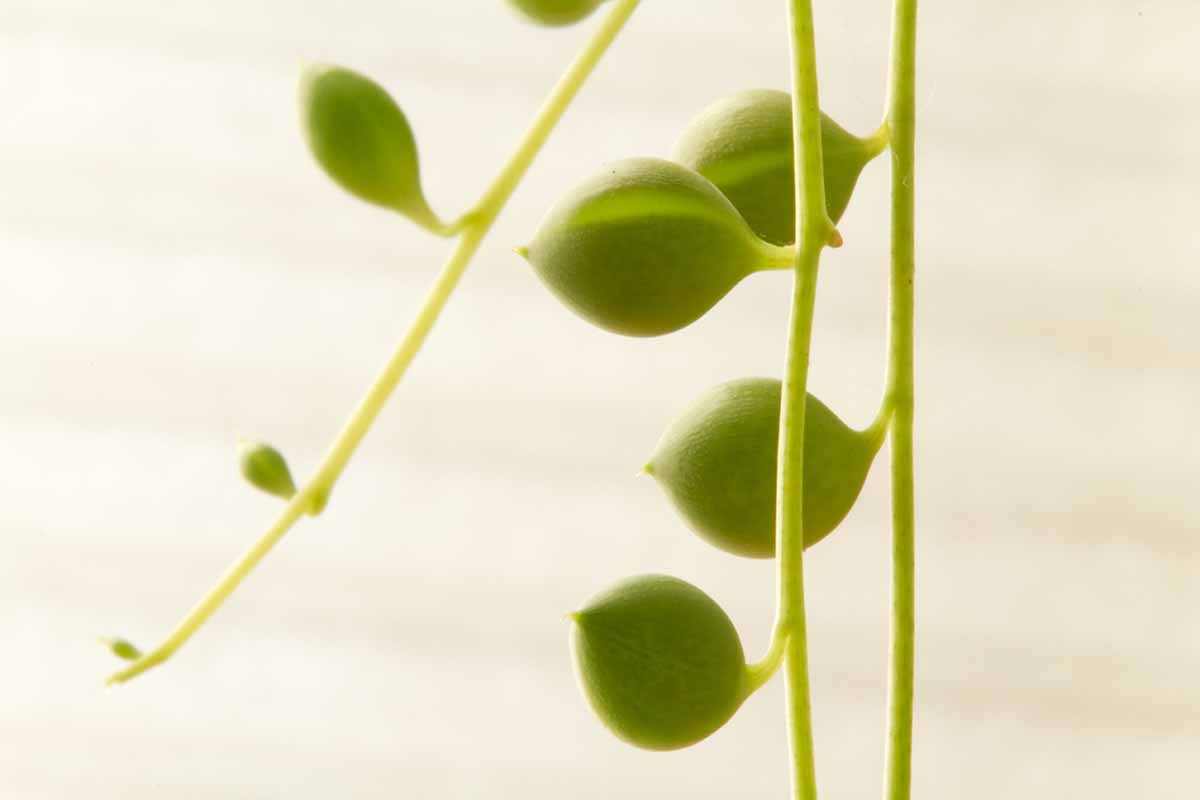
We’ll talk a little about the possibility of starting from seed in the pruning and maintenance section below.
From a Leaf
Choose a plump, unblemished leaf.
Use clean shears to snip the leaf from the vine.
Remove the short stem or petiole that attached the leaf to the vine.
Place the snipped leaf on a paper towel in bright indirect sunlight for about three days to dry and form a callus over the “wound.”
Once the leaf has formed a callus, fill a six-inch seed starter pot three-quarters full of cactus and succulent potting medium. Lightly moisten the medium.
Lay the leaf on top, and press it gently to anchor it in the moist medium.
Mist the soil as needed to keep it lightly moist but not soggy.
Keep the pot in a location with bright indirect sunlight, or use a grow light.
Over the next month or so, the leaf will wither as it grows roots and forms new foliage. New growth is evidence of success.
From a Stem Cutting
An even easier way to start a new plant is with a stem cutting.

Here’s how:
Cut a four-inch stem from the growing end of a long tendril.
Snip off the bottom leaf or leaves to create a bare stem one inch long.
Prepare the pot of soil as described above.
Insert the bare stem into the prepared medium.
Keep the medium lightly moist.
Place the pot in bright indirect sunlight or beneath a grow light.
New growth should appear in a few weeks.
Another way to root a stem cutting is to lay it flat on the surface of the potting medium.
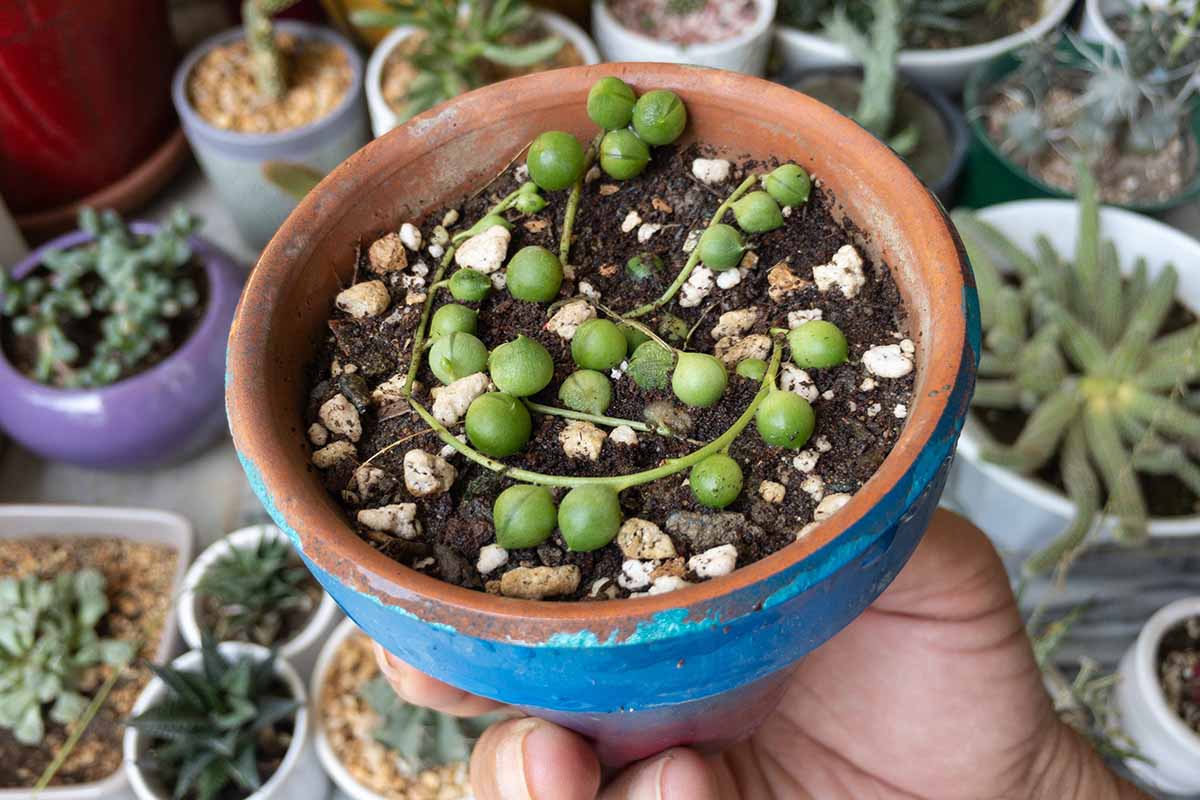
Here’s how:
Take a four-inch cutting.
Lay the cut stem on the moist medium. Press the pearls gently to anchor the stem to the medium.
Maintain moisture as described above and provide a bright indirect light source.
In addition to rooting in potting medium, you can root a stem cutting in water, as follows:
Take the cutting. Bare the bottom inch of the stem, removing any attached foliage.
Place the cutting in a small jar or glass filled with one inch of water.
For ideal sun exposure, make sure the top of the stem is a little taller than the container. It’s fun if the jar is clear and the roots are visible, so you can observe what’s happening.
If you don’t have a friend with vines you can snip, you’ll need to buy a plant.
From a Nursery Pot/Transplanting
When you purchase S. rowleyanus, it may be a small “start” that’s a few inches tall or a mature specimen.
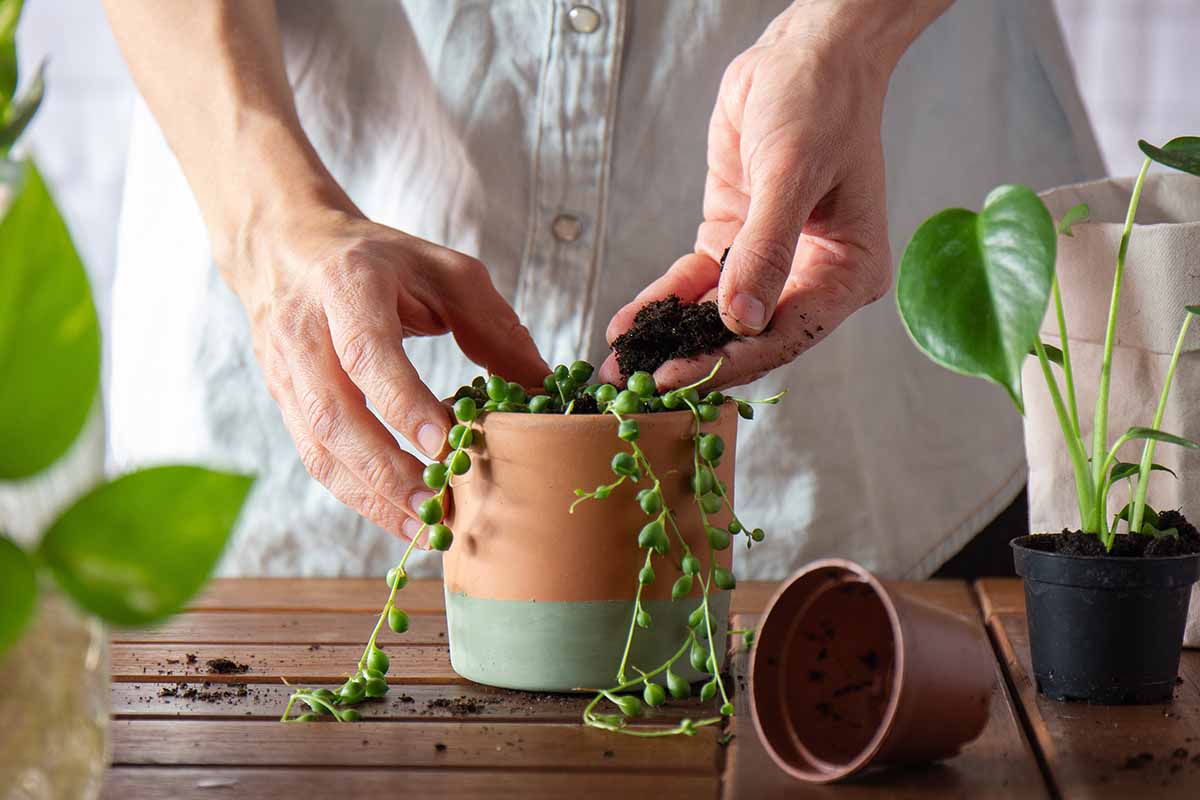
Either way, the time may come when you want to transplant it or a rooted cutting to a new container.
The secret to success is maintaining the same depth as in the original container. Succulents are susceptible to rotting, and those planted too deeply are the most vulnerable.
When foliage is even with or one-half inch below the pot rim, it’s more likely to thrive and less likely to rot.
Once propagated, it’s time to start a good care routine.
How to Grow
When choosing a container, check for ample drainage holes. If there is a matching drip tray, great. If not, find an old dish or lid that can catch excess water.

As succulents have shallow roots, depth is seldom a problem. However, it’s wise to select a pot with a fairly snug fit.
A diameter that is one inch wider than the foliage width allows room for the watering can spout. A pot that’s too big may stay wet for such a long time it causes roots to rot.
Use a potting medium that is light, airy, and well-draining. One formulated for cacti and succulents meets these specifications and typically has the appropriate slightly acidic pH of about 6.0 that succulents favor.
An excellent choice is Tank’s Pro Cactus and Succulent Mix.
Tank’s Pro Cactus and Succulent Mix
This product is made with coconut husks, compost, and pumice for water retention, drainage, and optimal growth.
Tank’s Pro Cactus and Succulent Mix is available from Arbico Organics in packages containing one and a half cubic feet of medium.
Remember to set rooted leaf cuttings, stem cuttings, and nursery plants at the same depth they were in their original containers, no deeper than half an inch from the pot rim.
Fertilize them with a liquid cactus and succulent food diluted to half strength. Feed monthly throughout the growing season.
A product you may like is Dr. Earth® Succulence® Cactus & Succulent Plant Food, 1-1-2 NPK.
Dr. Earth Succulence Cactus & Succulent Plant Food
This environmentally sound formulation is made from organic supermarket food waste and supports succulent health.
Mix one gallon at half strength, or use four pumps of food per gallon of water, to have on hand for biweekly applications. Apply with a watering can.
Dr. Earth® Succulence® Cactus & Succulent Plant Food is available from Arbico Organics in 16-ounce pump bottles.
When you water, take the pot to the sink if possible. Continue to pour water until it runs through the drainage holes. Allow the pot to drain for a few minutes and water again to moisten all air pockets.
Empty the drip tray as needed to avoid oversaturating the roots and raising the ambient humidity.
Water about once every two weeks or when the soil completely dries out. If you like, purchase a moisture meter to guide you. As discussed, it’s better to err on the side of too dry than too wet.
Do not use a mister. Wet leaves are prone to rotting, just like roots. Also, a mister increases the ambient humidity, which is fine for tropical flora but not for a desert succulent.
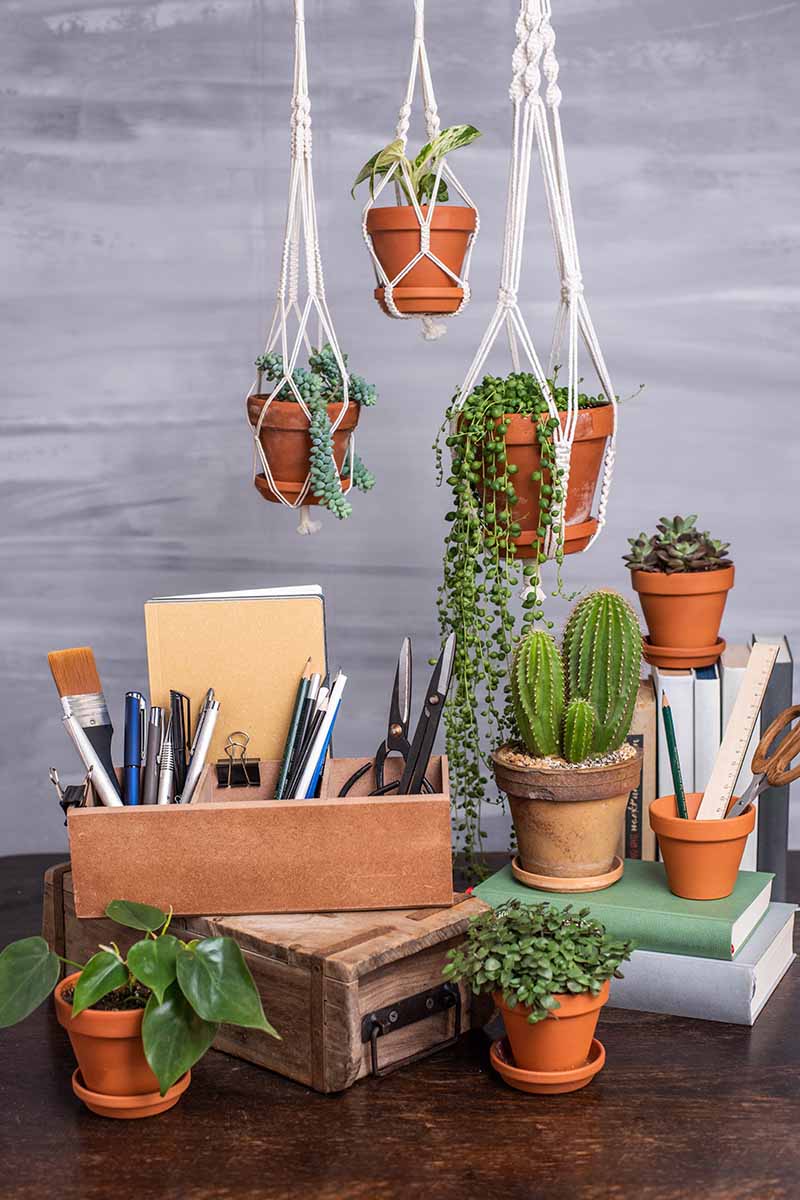
During dormancy, from fall to spring, you’ll find that you only need to water about once a month to keep the soil from completely drying out. Discontinue fertilizer applications during this time, but continue to provide adequate sunlight.
Succulents prefer household humidity between 30 and 50 percent. This is a healthy home range to have because, in addition to supporting desert plant health, it inhibits mold and dust mites, two common allergens.
Too much moisture can lead to rotting, whether from poor drainage, overwatering, or excessive humidity.
Provide your succulent with bright indirect sunlight. An eastern exposure or a distance of five to 10 feet from a sunny south-facing window is ideal.
You may find that you need to move the pot during the day to avoid bright direct light that may cause scorching.
Growing Tips
With good care, a succulent can last for many years. Give yours the best start by remembering to:
- Choose a well-draining pot, and remember to empty the drip tray.
- Use a loose, airy cactus and succulent potting medium to facilitate good drainage.
- Fertilize at planting time and monthly during the growing season.
- Water thoroughly and only when the pot completely dries out.
- Monitor household humidity and strive for 30-50 percent.
- Provide bright indirect sunlight.
Caring for string of pearls is easy with a good routine. Mark your calendar or garden planner with the approximate times to water and feed, so you don’t forget.
Occasionally, a little more care is required.
Pruning and Maintenance
Even with the best of care, a succulent occasionally requires additional tending.
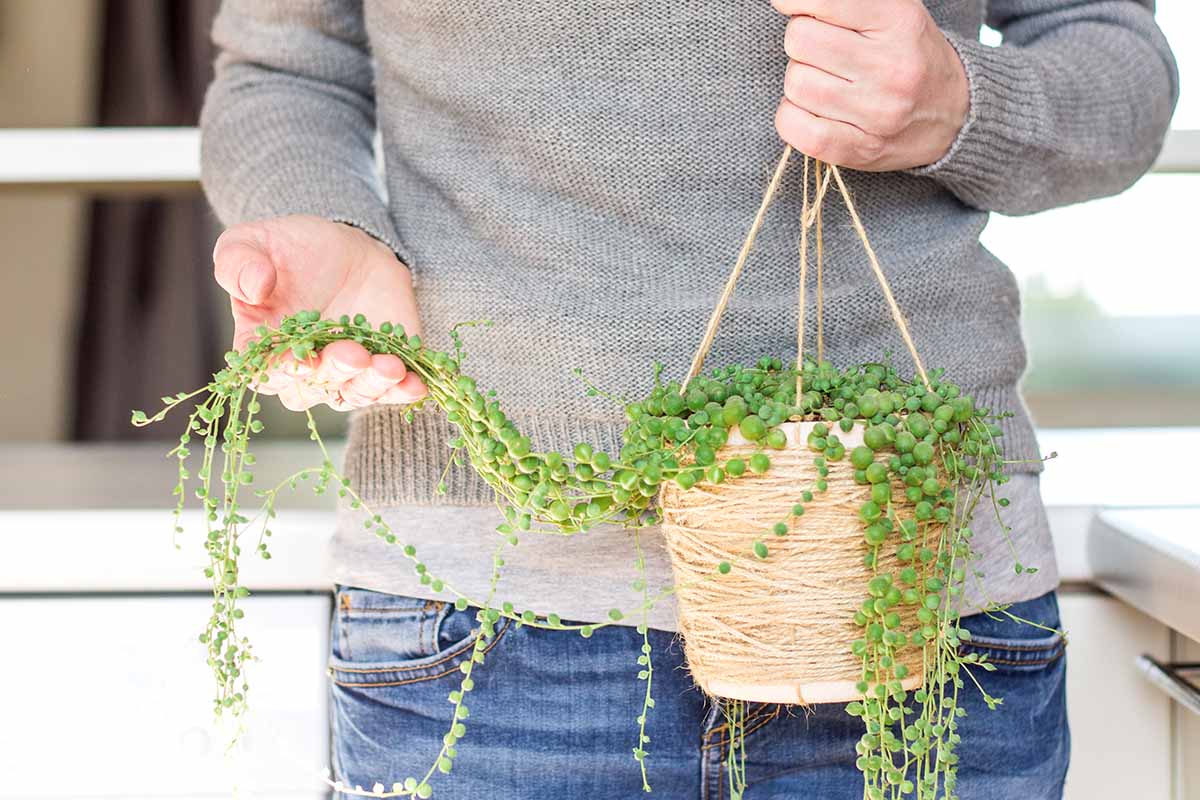
For example, if you are using your plant to make new ones, you may find that the ends of the tendrils branch off to form two or more offshoots instead of a single strand of leaves.
If you don’t like this appearance, snip off those you don’t want just below a leaf.
You should remove damaged, dead, or leafless stem portions to restore vigor and maintain an attractive appearance. Snip just below a leaf to promote rapid regrowth.
If you see dry, brown leaves, you may be underwatering, and/or the location may be too sunny. Evaluate your watering habits and the sun exposure and make adjustments as needed.
Oversaturation is likely if the leaves appear shrunken, squishy, and yellow. You may be able to dry a pot out by withholding water, but the damage may be irreversible. If you can, salvage a few good stems or leaves to propagate.
And in the event of a pest infestation, which we’ll discuss shortly, prune off badly affected foliage to restore health and visual appeal.
To encourage blooming, some folks put their succulents in a cool, dry 55 to 60°F location during winter dormancy to mimic nature and stimulate the process.
Another type of care you can provide involves time spent outdoors in the summer. Gradually acclimate plants to the outdoors a few hours each day and avoid scorching direct sunlight.
If humidity or rainfall are excessive, return them inside. Fresh air is rejuvenating for indoor flora and may invigorate underperformers.
Note that outdoor pollination may produce viable seeds. You can try to collect the little seed wisps before they drift off to sow on the surface of a lightly moistened cactus and succulent potting medium.
Keep the medium from drying out completely and place the germinating seeds in bright indirect sunlight.
Post-bloom, cut the flower stems as close to the vine as possible without severing it to restore vigor to the foliage and maintain a neat appearance.
Lastly, as the foliage grows wider, repot as needed to maintain a snug fit with an inch of room to water. Repot during dormancy to avoid disrupting growth.
Where to Buy
String of pearls is available from various sources, including discount stores and online vendors.
The CTS Air Plants Store offers three starter sizes:
- One 4-inch pot
- Two 2-inch pots
- One 6-inch hanging pot
Find string of pearls from the CTS Air Plants Store via Amazon now.
The variegated string of pearls, S. rowleyanus ‘Variegata,’ is another option.
It has green and white leaves with mottled and striped markings for an even more striking addition to succulent groupings. Variegated foliage may grow slower and be more sensitive to light than green.
Find variegated string of pearls now on Amazon, in four-inch pots.
Managing Pests and Disease
While our subject species is not prone to pests or diseases, dry indoor environments may attract aphids and mealybugs.
Try to dislodge pests with the kitchen sink sprayer. Follow up with an application of organic insecticidal neem oil.
As mentioned, rotting roots are common with oversaturated succulents. It may be best to try to salvage leaf and/or stem cuttings to start over in advanced cases.
Best Uses
A hanging container that allows vines to cascade around is a striking vessel for showcasing the unusual beaded strands of S. rowleyanus.
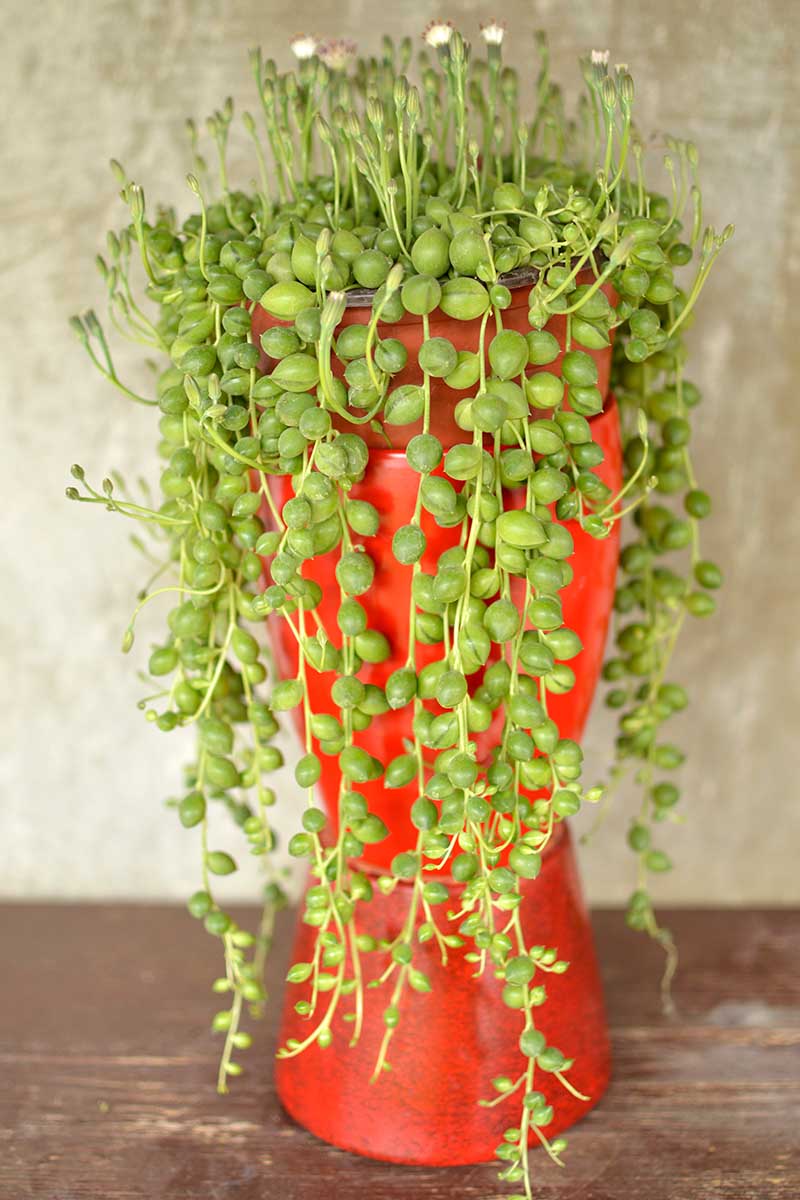
Use a non-hanging pot atop a pedestal, shelf, or mantel for a fresh, contemporary look.
Prune the vines to desired lengths, let them pool around the container, or sweep them to one side for dynamic variations.
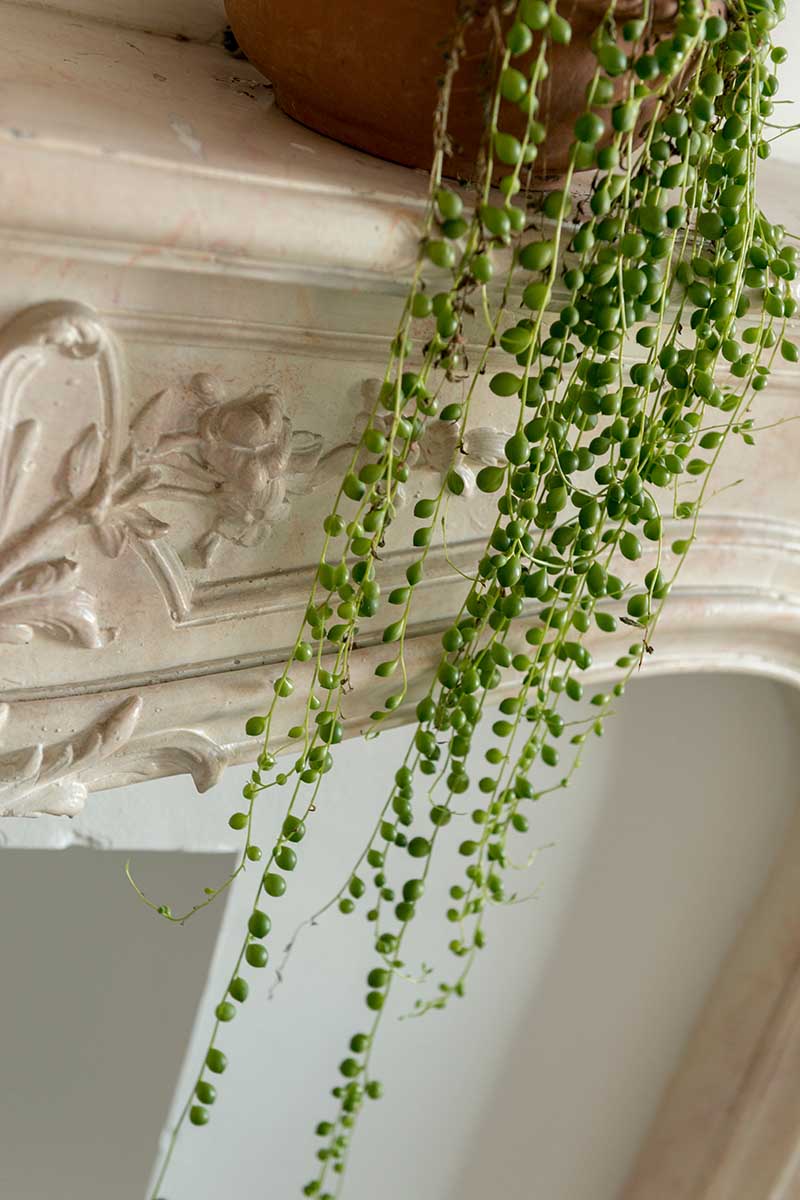
And finally, mimic nature and let the vines creep over the potting medium in a shallow container, forming a dense mat like a “pavé” floral arrangement – dense and low-profile. Prune wayward tendrils as desired.
A note of caution: keep tendrils out of reach of children or pets who may tug on them and topple a pot onto themselves.
Quick Reference Growing Guide
| Plant Type: | Succulent vine | Flower / Foliage Color: | White/green, variegated |
| Native to: | South Africa | Maintenance | Low |
| Hardiness (USDA Zone): | 9-12 | Tolerance: | Dry soil, humidity |
| Bloom Time: | Summer | Soil Type: | Succulent soil |
| Exposure: | Full sun to part shade | Soil pH: | Around 6.0 |
| Planting Depth: | Surface (seeds), same as original container (transplants) | Soil Drainage: | Well-draining |
| Height: | 1-2 feet | Uses: | Hanging or stationary houseplant, outdoor ground cover |
| Spread: | 1-2 feet | Order: | Asterales |
| Water Needs: | Low | Family: | Asteraceae |
| Growth Rate: | Fast | Genus: | Senecio |
| Common Pests and Diseases: | Aphids, mealybugs; root rot | Species: | Rowleyanus |
Dynamic and Decorative
I like succulent gardening and fell immediately in love with string of pearls.
It pairs well with rosettes of echeveria, ruffles of crassula, and spikes of haworthia, adding a new shape and movement with its spherical foliage and dangling stems.
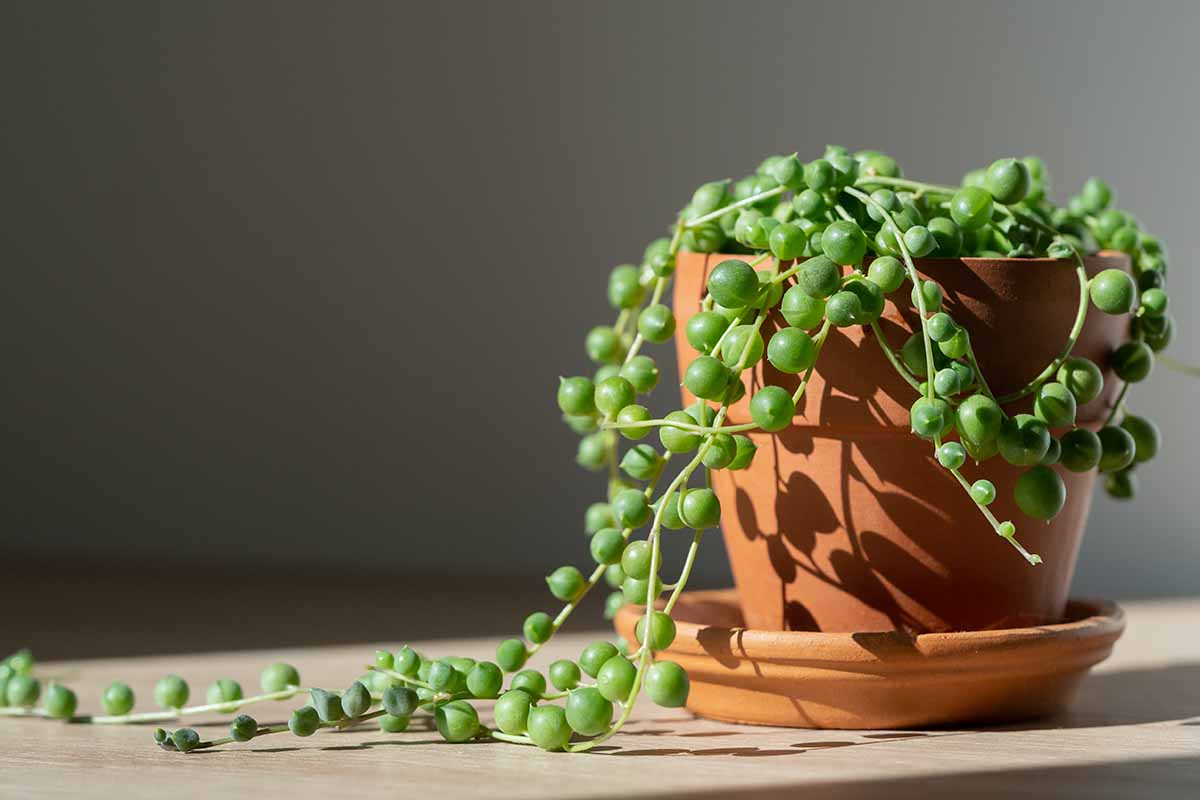
And when a species is also easy to care for and water-wise, it doesn’t take long for me to get on board, and I think you might be ready to join me.
Are you ready to add a dynamic string of pearls to your home decor? Will you suspend or display it in a stationary pot atop a shelf or mantel?
We’d love to hear about it in the comments section below.
If you enjoyed reading this article and want to read about more succulents to grow indoors, we recommend the following:


